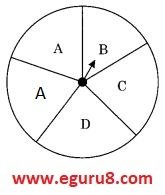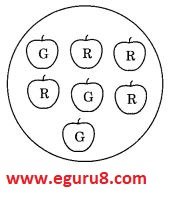NCERT Solutions Of Class 8 Maths Chapter 5 Data Handling
Introduction
Class 8 Maths Exercise 5.3 (Page-82)
Q1. List the outcomes you can see in these experiments.
(i) Spinning a wheel
(ii) Tossing two coins together

Solution:
i) There will be 4 outcomes i.e. A, B, C, D.
ii) HT, TH, HH, TT
Q2. When a die is thrown, list the outcomes of an event of getting
(i) (a) a prime number
(b) not a prime number
(ii) (a) a number greater than 5
(b) a number not greater than 5
Solution:
i)(a) 2,3 and 5 are the prime number.
i)(b) 1,4 and 6 are not prime number.
ii)(a) 6 is the number greater than 5.
ii)(b) 1,2,3,4 and 5 are the number not greater than 5.
Q3. Find the
(i) Probability of the pointer stopping on D in (Question 1-(a))
(ii) Probability of getting an ace from a well-shuffled deck of 52 playing cards?
(iii) Probability of getting a red apple, (see figure below)

Solution:
i) Probability = \(\displaystyle \frac{{Number\,of\,outcomes}}{{Total\,number\,of\,outcomes}}\)
= \(\displaystyle \frac{1}{5}\)
So, the Probability of the pointer stopping on D in (Question 1-(a)) is \(\displaystyle \frac{1}{5}\)
ii) Probability = \(\displaystyle \frac{{Number\,of\,outcomes}}{{Total\,number\,of\,outcomes}}\)
= \(\displaystyle \frac{4}{52}\)
= \(\displaystyle \frac{1}{13}\)
So, the Probability of getting an ace from a well-shuffled deck of 52 playing cards is \(\displaystyle \frac{1}{13}\)
iii) Probability = \(\displaystyle \frac{{Number\,of\,outcomes}}{{Total\,number\,of\,outcomes}}\)
= \(\displaystyle \frac{4}{7}\)
So, the probability of getting a red apple is \(\displaystyle \frac{4}{7}\)
Q4. Numbers 1 to 10 are written on ten separate slips (one number on one slip), kept in a box and mixed well. One slip is choosen from the box without looking into it. What is the probability of:
(i) getting a number 6?
(ii) getting a number less than 6?
(iii) getting a number greater than 6?
(iv) getting a 1-digit number?
Solution:
i) Probability = \(\displaystyle \frac{{Number\,of\,outcomes}}{{Total\,Number\,of\,Outcomes}}\)
=\(\displaystyle \frac{1}{{10}}\)
So, the probability of getting a number 6 is \(\displaystyle \frac{1}{{10}}\).
ii) Number less than 6 are 5,4,3,2 and 1.
Probability = \(\displaystyle \frac{{Number\,of\,outcomes}}{{Total\,Number\,of\,Outcomes}}\)
=\(\displaystyle \frac{5}{{10}}\)
= \(\displaystyle \frac{1}{{2}}\)
So, the probability of getting a number less than 6 is \(\displaystyle \frac{1}{{2}}\)
iii) number greater than 6 are 7,8,9 and 10. So,
Probability = \(\displaystyle \frac{{Number\,of\,outcomes}}{{Total\,Number\,of\,Outcomes}}\)
=\(\displaystyle \frac{4}{{10}}\)
=\(\displaystyle \frac{2}{{5}}\)
So, the probability of getting a number greater than 6 is \(\displaystyle \frac{2}{{5}}\).
iv) Number of 1 digit numbers are 9.
Probability = \(\displaystyle \frac{{Number\,of\,outcomes}}{{Total\,Number\,of\,Outcomes}}\)
=\(\displaystyle \frac{9}{{10}}\)
So, the probability of getting a 1-digit number is \(\displaystyle \frac{9}{{10}}\).
Q5. If you have a spinning wheel with 3 green sectors, 1 blue sector and 1 red sector, what is the probability of getting a green sector? What is the probability of getting a non-blue sector?
Solution:
Q6. Find the probabilities of the events given in Question 2.
Solution: